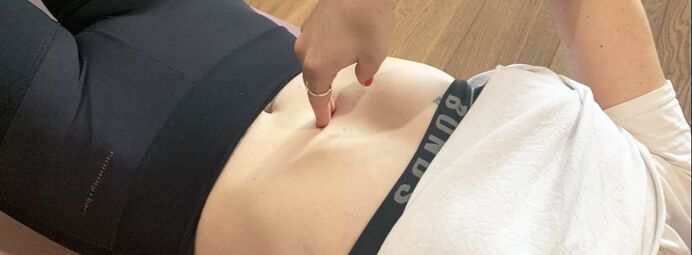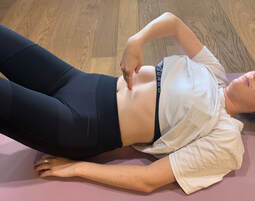
How to check for an abdominal muscle separation.
In the clinic, a thorough assessment can be carried out by one of our physiotherapists that aims to establish the integrity of these muscles and tissues but measuring the width, length, depth, tension, and surrounding muscle activity.
However, at home, you can assess yourself for the width and the tension.
How can I measure it at home?
- Lie down on your back with knees bent
- Place two fingers on your abdomen above the belly button to start

- Lift your head & shoulders off the floor in a mini crunch & feel for a gap or dip under your fingers
- Restart & repeat this process along the midline of the abdomen to feel the extent of the separation
A measurement of 2 fingers or more represents a separation & will require further rehabilitation. Although generally not painful abdominal muscle separation can consequently result in a poor truck and pelvic floor support due to the weakened abdominal wall.
Usually, this separation becomes apparent when women start noticing a bulge or doming in this area when getting out of bed or a chair.
What are the Do’s & Don’ts?
- DON’T … Engage in excessive straining (i.e. lifting, carrying, coughing, constipation, etc)
- DON’T … Perform exercise of trunk flexion or rotation (i.e. leaning forward, sitting up from lying, twisting)
- DON’T … Do crunches, sit-ups, oblique twists, or planks until advised by your Physio!
- DON’T… Hold your breath whilst exercising
- DO… Incorporate breathing exercises to help restore diaphragm movement & function
- DO… Focus on specific deep abdominal strengthening & coordination (i.e. transverse abdominus & pelvic floor)
- DO… Log roll out of bed if necessary
- DO… Be aware of posture & strengthening in varied positions
- DO … Progressively increase the load slowly to avoid exacerbations
- DO… Wear a post-natal abdominal support brace if necessary
- DO… Remember that everyone’s presentations & recovery times will vary
What exercises should I be doing?
Your physiotherapist will carry out a thorough assessment to get a better understanding of your situation but also your goals and your lifestyle. Some of the information that will be provided will be to make sure you are able to activate or use your deep core muscles that is the pelvic floor and the deep abdominal muscles- also known as transverse abdominous. These will build the foundations to progress to further loaded exercises & return to gym or sport.
Main key things to remember whilst doing exercises:
- Focus on activating the transverse abdominus (lower tummy muscle)
- Draw your belly button towards your spine to activate this muscle
- Continue to breathe normally into the diaphragm whilst doing exercise
- Perform exercises in varied positions for well-rounded strengthening
- Incorporate pelvic floor exercises for post-natal recovery where necessary
If you would like help with the assessment and management of a suspected abdominal wall muscle separation, do not hesitate to give us a call or contact us HERE.
Written by Sarah Henderson
REFERENCES
Axer et al. (2001), Collagen fibres in linea alba and rectus sheaths. I. General scheme and morpholpgical aspects. The Journal of Surgical Research 96(1): 127-134.
Beer et al. (2009), The normal width of the linea alba in nulliparous women. Clinical Anat. 22(6):706-711.
Benjaminm D. R., Frawley, H. J., Shields, N., van de Water, A.T.M., Taylore, N. F. (2017) Relationship between diastasis recti or the abdominal muscles (DRAM) and musculoskeletal dysfunctions, pain and quality of life: a systematic review. Physiotherapy
Bø K, Hilde G, Tennfjord MK, et al. (2017), Pelvic floor muscle function, pelvic floor dysfunction and diastasis recti abdominis: Prospective cohort study. Neurourol Urodyn, 36(3): 716–721.
Coldron et al. 2007 Postpartum characteristics of rectus abdominis on ultrasound imaging. Manual Therapy. E Pub.
Dierick, F., Galtsova, E., Lauer, C., Buisseret, F., Bouché, A.-F., & Martin, L. (2018). Clinical and MRI changes of puborectalis and iliococcygeus after a short period of intensive pelvic floor muscles training with or without instrumentation. European Journal of Applied Physiology, 118(8), 1661–1671.
Gillard, S., Ryan, C.G., Stokes, M., Warner M., Dixon, J. (2018) Effects of posture and anatomical location on inter-recti distance measured using ultrasound imaging in parous women. Musculoskelet Sci Pract 34: 1-7





